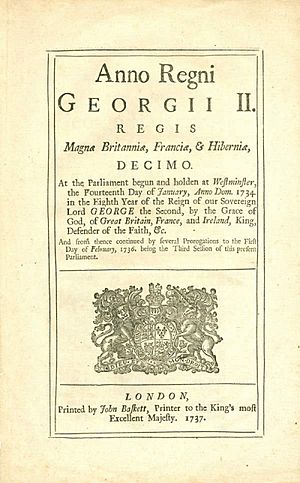John Baskett facts for kids
John Baskett (1664/5–1742) was a very important printer in England. He held the special job of King's Printer. This meant he was officially allowed to print important government documents, Bibles, and prayer books for the King. John made sure his family stayed involved in printing for many years. His sons, Thomas and Robert, and his grandson, Mark, also worked in the printing business.
Contents
John Baskett's Printing Story
John Baskett was a clever businessman. He once asked the government for a job. He said he had saved the King lots of money by providing special paper for the navy. This was around 1694.
The right to print Bibles was very old. It started with printers named Christopher and Robert Barker. Their family kept this right until 1709. After that, the right went to Thomas Newcomb and Henry Hills. John Baskett and others later bought this printing right from their families.
In 1713, Benjamin Tooke and John Barber became the next Queen's Printers. Their turn would start in 1739. But John Baskett bought their future printing rights too. He then got a new agreement to print for sixty more years. Later, his family sold the last thirty years of this right for a lot of money.
Eventually, the printing rights went to other families. Today, the company Eyre & Spottiswoode holds these old printing rights.
Printing the Book of Common Prayer
The first Bible printed by Baskett's group came out in 1710. John Baskett's name first appeared on a New Testament in 1712. He started printing the Book of Common Prayer in 1713. He made different sizes: large, medium, and small.
Baskett became the leader of the Company of Stationers in 1714 and 1715. In 1715, he printed four different sizes of the Bible.
The Famous 'Vinegar Bible'
One of his most famous Bibles was printed in Oxford. It was a very beautiful, large two-volume Bible. The Old Testament came out in 1717, and the New Testament in 1716.
This Bible is known as 'The Vinegar Bible'. This is because of a mistake on one page. The heading for St. Luke, chapter 20, accidentally said 'The parable of the vinegar'. It should have said 'The parable of the vineyard'. People even joked that it was 'A Baskett-full of printers' errors' because of how many mistakes it had.
Some special copies of this Bible were printed on vellum. Vellum is a very fine type of parchment. Three of these rare copies are known today. One is in the British Museum. Another is in the Bodleian Library. A third was once at Blenheim Palace.
Legal Battles Over Printing
John Baskett was known for trying to control Bible printing. He had many legal fights, especially in Scotland. These fights started in 1715.
In Scotland, James Watson was also a King's Printer. He believed he had the right to print Bibles and sell them anywhere in the United Kingdom. But Baskett disagreed. He sued Watson's agent for selling Bibles printed in Edinburgh in England. This legal battle lasted a long time. Finally, a judge named Lord Mansfield decided in Baskett's favor.
Challenges and Later Years
In 1731, the University of Cambridge allowed others to print Bibles and prayer books. This led to more legal problems for Baskett. He even faced issues with new printing methods like stereotype printing.
Around 1738, Baskett's printing office burned down. Other printers helped him recover from his losses. John Baskett's name last appeared on a New Testament in 1742. He died on June 22, 1742.
His sons, Thomas and Robert, continued the family business. They printed the Old Testament in 1743. Thomas Baskett's name appeared on Bibles until 1769.
The American Bible Mystery
John's grandson, Mark Baskett, also printed Bibles. His name is part of an interesting printing mystery in America.
A historian named Isaiah Thomas said that a Bible was printed in Boston around 1752. This would have been the first Bible printed in English in America. But it had a fake London imprint. It said "London: printed by Mark Baskett, printer to the king's most excellent majesty." This was done to avoid legal trouble.
Thomas heard this story many times. He even said a governor owned a copy. About 700-800 copies were supposedly made. A New Testament was also printed secretly in the same way. However, no one has ever found a copy of these Bibles or Testaments. Mark Baskett's name didn't even appear on Bibles until 1761. So, this remains a printing mystery.


